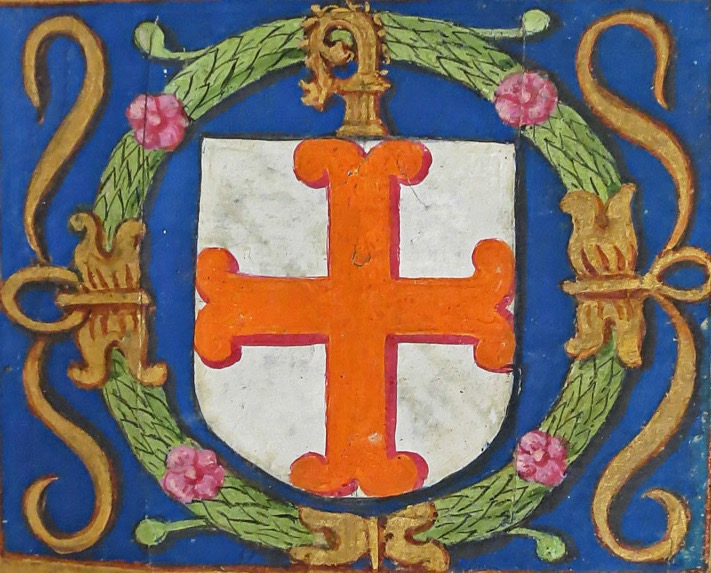I think this column may need a trigger warning: it’s about heraldry, specifically the coats of arms of medieval monasteries. Ok, it might not be a subject that offends, but I’m sure that more than a few of you are already going into sleep mode.
However, I beg you to give me the benefit of the doubt and carry on reading. I hope to show that the topic is every bit as colourful and intriguing as the brightly painted shields that adorned the walls, windows and manuscripts of medieval monasteries. What’s more, an examination of heraldry can provide fascinating insights into the medieval mind, including how monasteries formed and projected their identities, their place in wider society, and the status anxiety and social climbing of abbots and priors in the late Middle Ages.
First some background.
The origins of heraldry go back to the late 12th century when kings, nobles and knights started to decorate the shields and banners they carried into battle with colourful beasts or geometric designs. These easily recognisable symbols enabled combatants to identify friend or foe in the chaos of warfare.
Heraldry also signified status, distinguishing its bearers as members of a military and social elite. It also became an integral part of the world of chivalry, a code of conduct that provided the knightly classes with a veneer of civilisation, tempering behaviour that was every bit as thuggish and immoral as modern gangland conflict.
Religious institutions across Europe soon adopted the use of heraldry, and by the end of the Middle Ages most English monasteries had their own coat of arms, prominently displayed on their seals and buildings.
In many cases these arms were a version of those the noble who founded the monastery in the first place. Byland Abbey (Yorkshire) and Hailes Abbey (Gloucestershire) are good examples. In both cases, the founders’ arms were slightly changed (or, to use the nerdy term, “differenced”) by the inclusion of a crosier, a symbol of obvious monastic significance.
This “differencing” was necessary because each coat of arms was meant to be unique to an individual or institution. The knightly classes got very worked up indeed if they thought their heraldic rights were being violated. At the end of the 14th century, Sir Richard Scrope of Yorkshire and Sir Robert Grosvenor of Cheshire were horrified when they found out they were using an identical shield of arms: Azure, a bend Or (in other words, a blue background with a gold diagonal band from top right to bottom left). A meeting of the Court of Chivalry was convened, the case as hotly contested as any modern dispute about copyright infringement.
Witnesses, including the heads of several monasteries, were summoned by both claimants. The testimony abbots of Byland, Easby, Rievaulx and Roche, make interesting reading, showing just how widespread heraldic decoration was in the churches of medieval monasteries.
This was utterly unproblematic for patron and monastery alike. For the benefactor, it affirmed their family’s prestigious association with a religious house. For the monks, it indicated they were fulfilling their pious obligations by sustaining memory of their benefactors, whose backing they could call on if needed.
The gatehouse of Kirkham Priory makes the point: it’s replete with the coats of arms of local bigwigs. But the heraldry at Kirkham is also capable of a religious interpretation, and would have evoked a Biblical passage that describes the bucklers, or shields, decorating the Tower of David. The gatehouse would have been allegorised as nothing less than the entrance to the Heavenly Jerusalem.
This pious use of heraldry meant that the Trinity, Christ, the Virgin, Apostles and many other saints were given their own distinctive coats of arms. The use of such sacred heraldry by a monastery often emphasised an association with a saint held in special reverence by its community. Durham Cathedral Priory is a good example. It used the made-up arms of Cuthbert, the great Northumbrian Anglo-Saxon monastic saint whose relics rested in its church.
The arms adopted by monasteries could also be whimsical. Some used heraldic designs that deliberately canted on the name of the abbey or priory. In the Middle Ages the name of Coggeshall abbey (Essex) was pronounced ‘Cockshall’ and its arms accordingly featured three cocks.
Late medieval monastic superiors showed an especial fondness for canting heraldry, many using rebuses (visual puns) on their names. Some were very inventive indeed. My favourite is the rebus of John Islip, abbot of Westminster (d. 1532). It includes a depiction of an eye and a boy slipping from a tree.
By Islip’s time, a select group of abbots and priors even had their own proper coats of arms. A few monastic superiors came from families posh enough to claim their own shield. Richard Gower, abbot of Jervaulx in Yorkshire at the turn of the 15th century, is a good example. Gower made sure that people knew he was to be counted among the social and ecclesiastical elite. He’s depicted on his seal wearing a mitre, which he’d recently received permission from the pope to use, flanked by his family coat of arms and those of his abbey.
The late medieval Church was also an avenue of social mobility, and humbly born priests and monks rose through the ranks to become prelates of sufficient ecclesiastical, social and political stature to receive an official grant of arms. Their number included John Essex, the last abbot of St Augustine’s Abbey, Canterbury, whose arms included the face of a leopard. This was an appropriate beast to feature on the arms of a celibate cleric: leopards were believed to be sterile, and as, a medieval heraldic tract explained, to “have the apparatus of procreation but not the power to use it”.
Abbots and priors used personal heraldry to adorn the building works completed during their tenure of office. On one level, this was unashamedly self-advertising, affirming their exalted status and fixing their place in the institutional memory of their monasteries.
But it’s important not to be too cynical. This heraldry also had an explicitly pious purpose and was intended to elicit prayers of salvation. Moreover, if showing off was all that really mattered, why were the coats of arms of benefactors frequently placed at such a height that they couldn’t be seen from ground level? The answer is simple: they were visible to God, the only audience that really mattered.



 Loading ...
Loading ...
What do you think?
You can post as a subscriber user ...
User comments (5)
This is an excellent observation and deserves the widest possible circulation. Just click om the social media sites so that your friends, parishioners and Bishop friends can read it for themselves.
Fr. Tom Grufferty
Once again the enigmatic "The Vatican" swoops down and show that the slightest bit of opening toward transparency does not please whomever "The Vatican" is in this case.
This reaction is not surprising to many of us who were skeptical ... and remain so ... about this entire process from the first day on.
I recall the early days of Vatican2 when the Curia presented the assembled Bishops with documents to work on. I think it was four cardinals who more of less tore them up saying they were unacceptable. A few weeks later they produced new documents which were discussed and we know the results. Does the Vatican never learn or maybe they forgot.
Arguably the results are more likely to make a difference if they are brought to the synod without being pre-empted beforehand.
Sadly, the attitude of our bishops does not surprise me.
My diocese publishes details of parishioners' financial contributions in its yearbook but as yet I have failed to access its most recent audited published accounts.
Worse still seems to be a complacency that accepts the future is one of declining congregations.
The concept of 'the remnant' - a smaller, purer church seems acceptable.
Where is leadership?
Where is there a genuine, outward-looking desire to evangelise?
We hear much of the need for priests but without congregations there will be no need for priests!
The laity do not just look for leadership but for their views to be taken seriously.
Thank God, Pope Francis is speaking to the world.
Our bishops need to listen to us and to him.